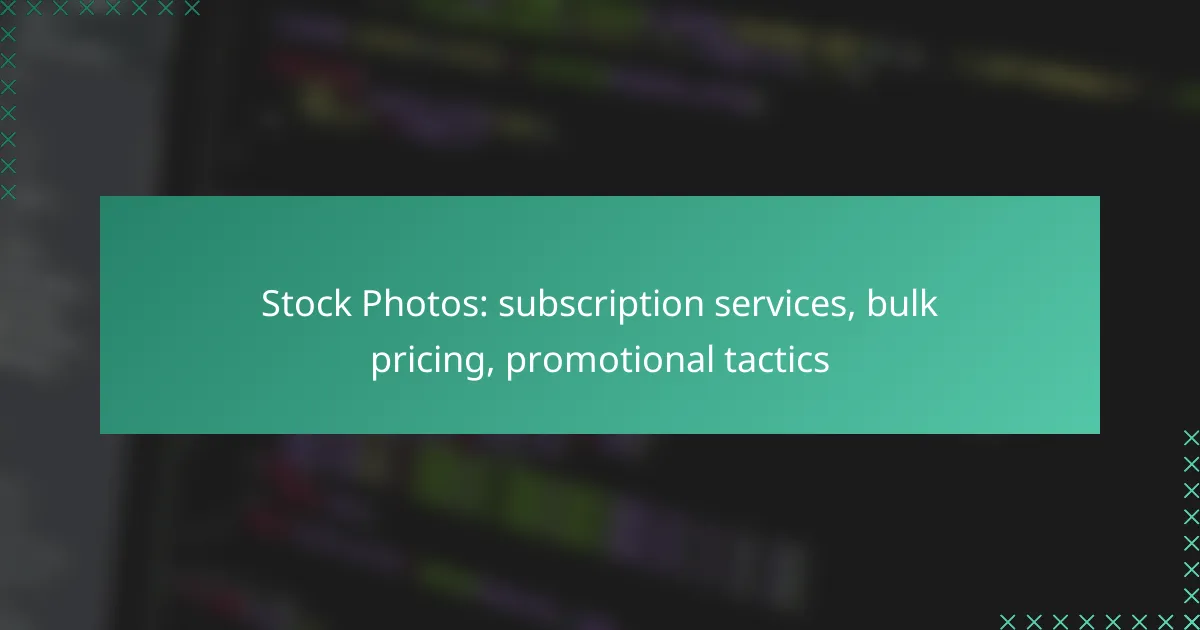Stock photo subscription services offer a convenient way for businesses and creatives to access vast libraries of high-quality images for a monthly fee. When selecting a service, it’s essential to consider factors such as pricing models, licensing terms, and the variety of images available. Additionally, bulk pricing options can provide significant savings for those needing a large volume of images, making it easier to find a solution that fits both budget and requirements.
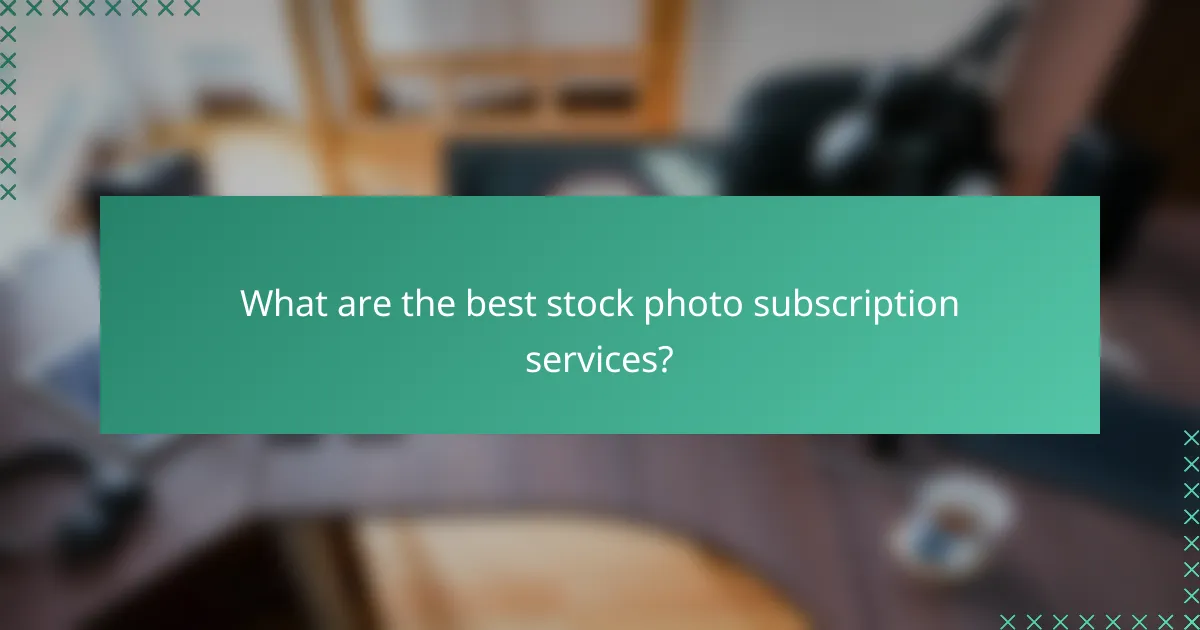
What are the best stock photo subscription services?
The best stock photo subscription services provide access to extensive libraries of images for a monthly fee, making them ideal for businesses and creatives needing regular content. Key factors to consider include pricing, image quality, licensing terms, and the variety of available images.
Adobe Stock
Adobe Stock offers a vast collection of high-quality images, illustrations, and videos that seamlessly integrate with Adobe Creative Cloud applications. Subscription plans start at around $29.99 per month for 10 standard assets, allowing users to easily access and manage their media.
One advantage of Adobe Stock is its user-friendly interface and advanced search capabilities, which help users find the right images quickly. However, the cost can add up for those needing more than the basic plan, so evaluate your usage needs before committing.
Shutterstock
Shutterstock is one of the largest stock photo services, boasting millions of images, videos, and music tracks. Their subscription plans begin at approximately $49 per month for 10 images, with options for larger packages that offer better value for frequent users.
Shutterstock’s extensive library and diverse content types make it a popular choice among marketers and designers. However, users should be aware of the licensing restrictions, especially for commercial use, to avoid potential legal issues.
iStock
iStock, a subsidiary of Getty Images, provides a range of affordable stock photos, illustrations, and videos. Their subscription plans start at around $29 per month for 10 credits, which can be used to download various types of media based on their credit value.
iStock is known for its flexible pricing and diverse image collections, making it suitable for small businesses and freelancers. However, the quality can vary, so it’s advisable to review images before purchasing credits.
Getty Images
Getty Images is renowned for its premium stock photos and editorial content, catering to high-end clients and media outlets. Pricing is generally higher, with subscription options starting at about $175 per month for a limited number of images.
While Getty Images offers unparalleled quality and exclusivity, the cost may not be feasible for all users. Consider your budget and the specific needs of your projects when exploring this service.
Dreamstime
Dreamstime provides a mix of free and paid stock photos, making it accessible for various budgets. Subscription plans begin at around $39 for 10 images, with bulk pricing available for larger packages.
This service is particularly appealing for those seeking a cost-effective solution without sacrificing quality. However, the selection may not be as extensive as larger competitors, so users should assess their specific image requirements before choosing Dreamstime.
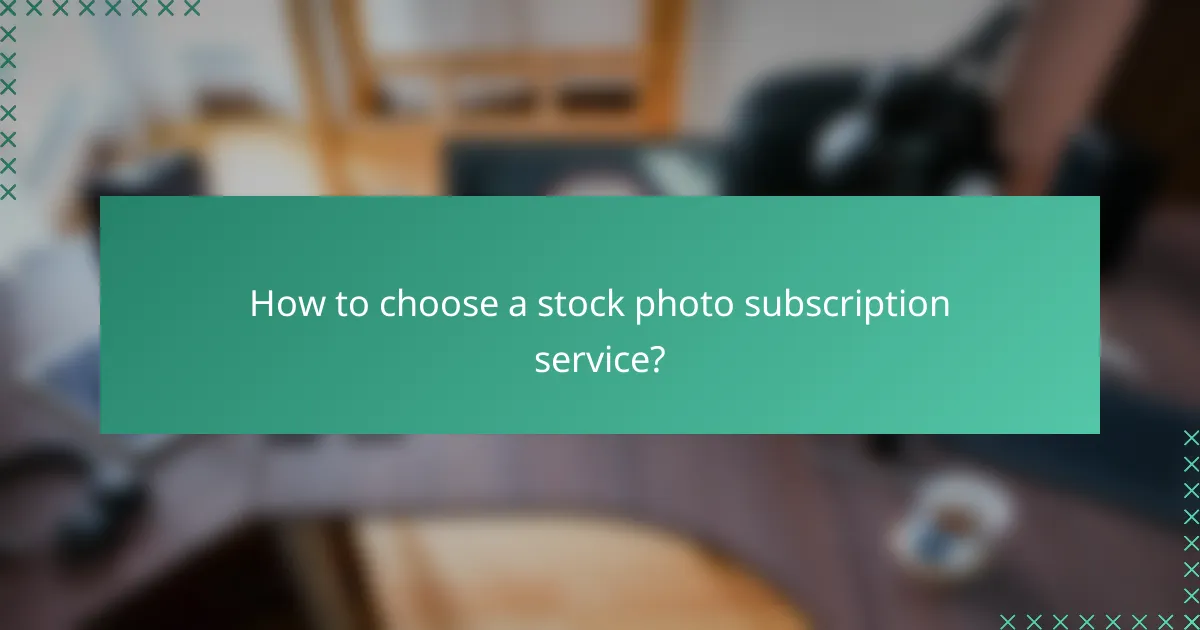
How to choose a stock photo subscription service?
Choosing a stock photo subscription service involves evaluating image quality, pricing models, and licensing options. These factors will help you find a service that meets your specific needs and budget.
Evaluate image quality
Image quality is crucial when selecting a stock photo service. Look for high-resolution images that are sharp and clear, as these will enhance your projects. Many platforms offer sample images, so take advantage of these to assess the quality before committing.
Consider the variety of styles and subjects available. A diverse library can provide more options for different projects, ensuring you find the right visuals that align with your brand or message.
Consider pricing models
Pricing models for stock photo subscriptions can vary significantly. Some services offer monthly or annual plans, while others may charge per image or provide bulk purchasing options. Assess your usage needs to determine which model is most cost-effective for you.
For instance, if you need a large number of images regularly, a subscription plan may save you money compared to one-off purchases. Compare the costs of different services to find the best deal that fits your budget.
Assess licensing options
Licensing options dictate how you can use the images, so it’s essential to understand the terms. Most stock photo services offer standard licenses for personal and commercial use, but some may have restrictions on distribution or modification.
Check for extended licenses if you plan to use images in high-visibility projects or for resale. Always read the fine print to avoid any legal issues down the line, ensuring that the licensing aligns with your intended use.
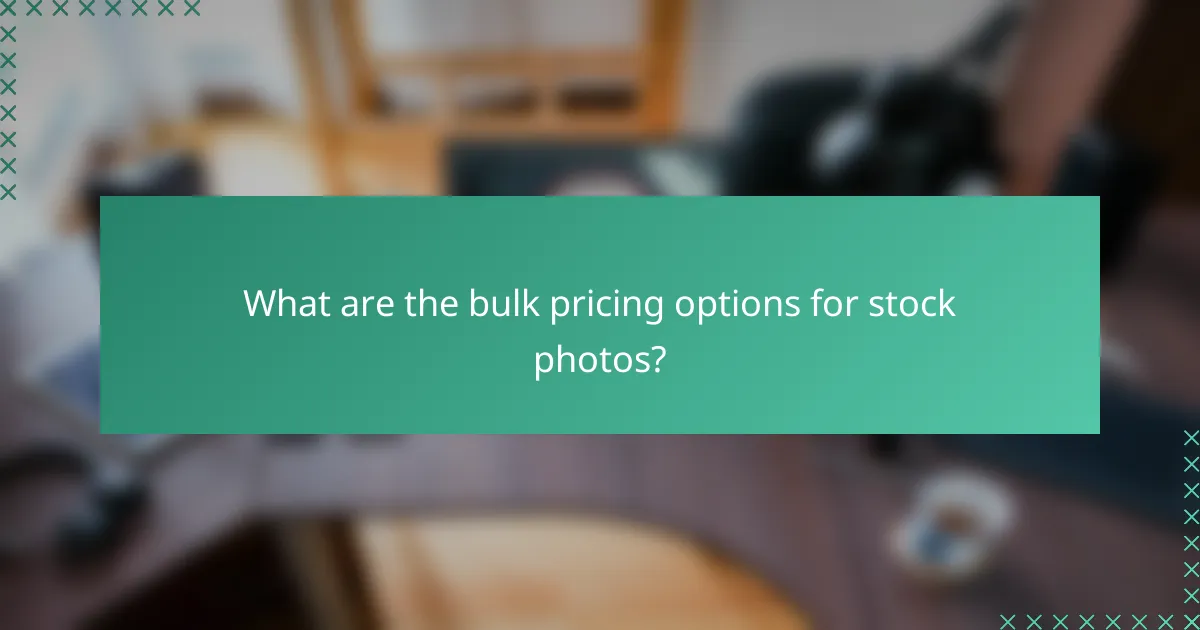
What are the bulk pricing options for stock photos?
Bulk pricing options for stock photos allow users to purchase multiple images at a reduced rate, making it more cost-effective for businesses and individuals who need a large volume of images. These options vary by provider and can include discounts, credit packs, or subscription plans tailored to different needs.
Shutterstock bulk discounts
Shutterstock offers bulk discounts through its image packs, which allow users to buy a set number of images at a lower price per image compared to single purchases. Typically, the more images you buy, the greater the discount, with options ranging from small packs of around 5 images to larger packs of 50 or more.
When considering Shutterstock’s bulk discounts, it’s essential to evaluate your needs carefully. If you frequently require stock images, purchasing a larger pack can significantly reduce costs. However, ensure that the images you select are relevant to your projects to avoid wasting credits.
Adobe Stock credit packs
Adobe Stock provides credit packs that allow users to purchase credits in bulk, which can be redeemed for images, videos, and templates. These packs come in various sizes, typically starting from around 10 credits and going up to 750 credits, with larger packs offering better value per credit.
Using Adobe Stock credit packs can be advantageous for businesses that need flexibility in their image selection. However, be mindful of the expiration dates on credits, as unused credits may expire after a certain period, potentially leading to lost value.
iStock subscription plans
iStock offers subscription plans that provide a set number of downloads per month at a fixed price, making it a great option for users who regularly need stock photos. Plans vary, allowing for anywhere from 10 to 750 downloads monthly, with different pricing tiers based on the number of images and the type of content (standard or premium).
When choosing an iStock subscription, consider your monthly image needs and whether you can utilize the downloads fully. Subscriptions can save money compared to one-off purchases, but ensure you select a plan that aligns with your usage patterns to maximize value.

How to effectively promote stock photos?
To effectively promote stock photos, focus on targeted marketing strategies that reach potential buyers where they are most active. This includes utilizing social media platforms and leveraging email campaigns to engage your audience and showcase your offerings.
Utilize social media marketing
Social media marketing is a powerful tool for promoting stock photos. Platforms like Instagram, Pinterest, and Facebook allow you to share visually appealing content that can attract potential customers. Regularly post high-quality images, behind-the-scenes content, and user-generated photos to build a community around your brand.
Consider using targeted ads to reach specific demographics. For example, if your stock photos cater to businesses, focus on LinkedIn ads. Utilize hashtags relevant to your niche to increase visibility and engage with followers through comments and direct messages to foster relationships.
Leverage email campaigns
Email campaigns can effectively promote stock photos by delivering curated content directly to your audience’s inbox. Create a mailing list of interested customers and send regular newsletters featuring new stock photo collections, special discounts, or tips on using your images.
Segment your email list to tailor messages based on user preferences or past purchases. This personalized approach can increase engagement rates. Include clear calls to action, such as links to your website or specific photo collections, to drive traffic and conversions.

What are the benefits of using stock photos for digital products?
Using stock photos for digital products offers significant advantages, including cost savings and time efficiency. These images can enhance visual appeal while allowing creators to focus on content rather than photography.
Cost-effectiveness
Stock photos are often more affordable than hiring a professional photographer. Subscription services typically offer a range of pricing plans, allowing users to access thousands of images for a monthly fee, which can be more economical than purchasing images individually.
Many platforms provide bulk pricing options that further reduce costs. For example, purchasing a package of credits can lower the per-image price, making it easier for businesses to manage budgets while still obtaining high-quality visuals.
Time-saving
Stock photos save time by eliminating the need for image creation from scratch. Users can quickly search and find images that fit their needs, often within minutes, rather than spending hours or days on a photoshoot.
Additionally, many stock photo websites feature advanced search filters that help users find specific styles or themes efficiently. This streamlined process allows creators to focus on other aspects of their projects, enhancing overall productivity.
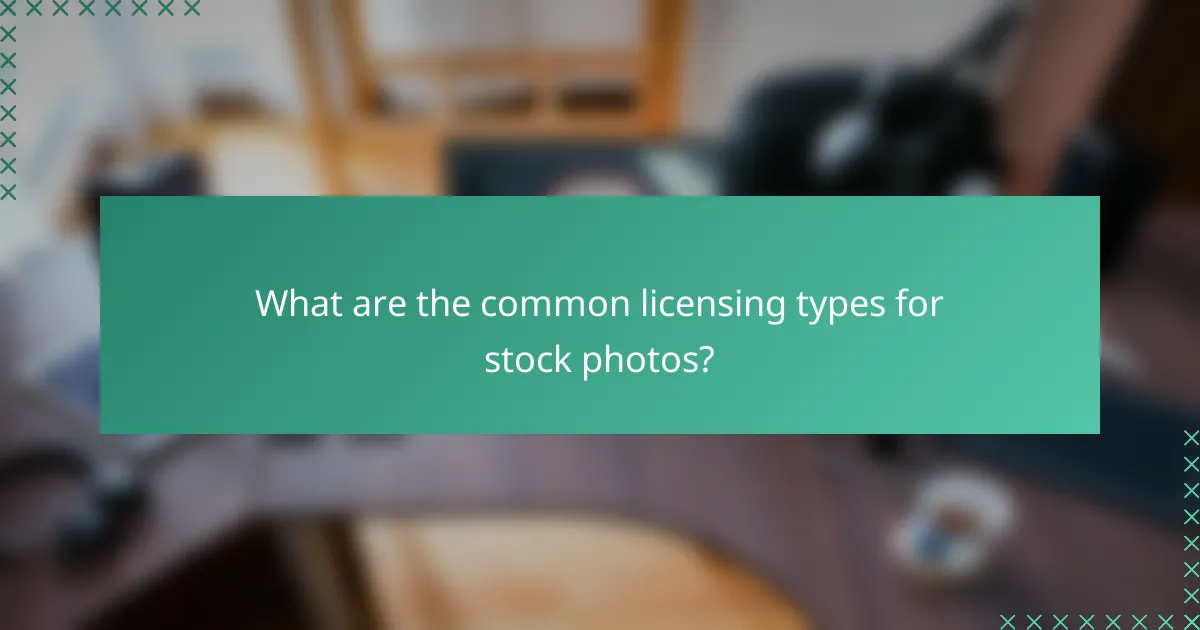
What are the common licensing types for stock photos?
Stock photos typically come with various licensing types that dictate how they can be used. Understanding these licenses is crucial for selecting the right images for your projects while ensuring compliance with legal requirements.
Royalty-free licenses
Royalty-free licenses allow users to pay a one-time fee to use an image multiple times without incurring additional costs. This type of license is popular among businesses and individuals who need flexibility in how they use stock photos.
When purchasing royalty-free images, consider the specific usage rights granted. Most royalty-free licenses permit commercial use, but restrictions may apply to resale or redistribution. Always read the terms to avoid potential pitfalls.
For example, a royalty-free image might cost between $10 to $100, depending on the provider and image quality. This makes it a cost-effective option for projects requiring multiple images over time.
